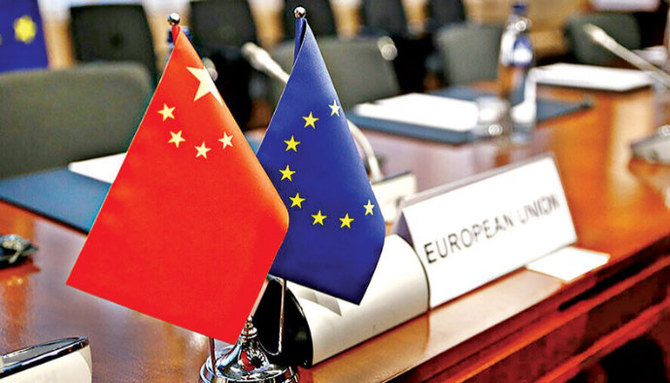Andrew Hammond
EU politicians, in particular European Commission President Ursula von der Leyen, are increasingly framing their policy on China as one of “de-risking.” However, the block and its 27 member states currently lack the toolbox required to deliver on this, imperfectly defined, ambition.
This leaves Brussels facing a huge political challenge, to say the least. Little wonder, then, that von der Leyen and others gave such a warm welcome to the EU’s recent decision to grant final approval for a new, so-called European anti-coercion tool.
The measure, intended as a deterrent, will enable the EU to impose countermeasures on any third-party country, including China, that attempts to exercise economic coercion over member states. Available countermeasures include increased customs duties, intellectual property restrictions, or export controls.
One key trigger for development of the anti-coercion tool was the alarm in several member states about China’s blockade of EU member Lithuania, over the Baltic nation’s deepening ties with Taiwan. After allowing Taiwan to open a representative office in its capital, Vilnius, in 2021, Lithuania was subjected to a Chinese ban on exports.
The new EU regulations, which are due to be signed on Nov. 22 and come into force 20 days later, represent a potentially major milestone in the bloc’s new economic-security strategy, which proposes to carry out a thorough assessment of possible threats in four areas: risks to the resilience of supply chains, including energy security; risks to the physical security and cybersecurity of critical infrastructure; risks related to the security and leakage of technology; and risks of the weaponization of economic dependencies or economic coercion.
At the forefront of this economic-security debate in Brussels is the “de-risking” of China. This was highlighted recently by EU foreign policy chief Josep Borrell when he cited the huge trade imbalance between the bloc and China, which stands at about €400 billion ($435 billion) in China’s favor.
On Nov. 16, von der Leyen said that this huge deficit is “the calculated and declared result of China’s trade and security policy. China’s declared strategy is to reduce its dependence on the world and at the same time increase the world’s dependence on China.” She therefore urged the EU to speed up the process of de-risking Beijing.
Borrell highlighted the importance of addressing this issue in his own comments few weeks ago, when he said “it is … in our mutual interest to find common ground, to redress the imbalance in our economic and trade relations. Otherwise, de-risking may indeed accelerate far more than is good, as the public opinion will increase its pressure on political leaders to disengage more from China.”
However, the lack of clarity over exactly what “de-risking” actually means increases the possibility of EU policy failure rather than success. Part of the challenge is that opinions within the EU 27 significantly diverge on these issues so, despite the significant tensions with China, it will not be a straightforward matter to secure an ongoing policy consensus.
For example, de-risking looks different to many policymakers in Germany, given the nation’s deep economic ties with China, than it does to their counterparts not only in Lithuania but other key, hawkish Eastern European nations. Germany is, by far, China’s biggest trading partner within the EU, and the nation’s firms also hold sizable investments in the country.
Within this large arena of European policy on Beijing there are some other signals, beyond the anti-coercion tool, about what de-risking might look like, based on what von der Leyen described as a need for “a clear-eyed picture of what the risks are.”
A growing number of EU decision-makers, for instance, want to make better use of existing export controls, foreign direct investment screening, and foreign subsidy instruments. Take the example of investment screening: Not all EU countries had screening in place as recently as 2021, and even where it existed, Brussels had no formal legal power to block investments.
Building on this, the new framework is likely to include efforts to reduce dependency and diversify supply chains away from Beijing, especially in areas where the EU needs to enhance its green and digital economies.
We can therefore anticipate greater European interest in African and Latin American countries with great mineral resources, and higher prominence for initiatives such as the EU’s Global Gateway strategy for investment in infrastructure projects and economic partnerships based on certain key principles.
Key elements of the new EU framework are also likely to include measures von der Leyen said are needed for the “bolder and faster use” of new economic tools against China. These include the roll-out of regulations on foreign subsidies that would give the EU extra muscle to fight the distortion of subsidies businesses can receive. The aim is to give Brussels greater powers to prevent state-subsidized companies in China, or other non-member nations, producing goods in Europe.
Another tool that the EU looks set to develop is what von der Leyen calls “a targeted instrument on outbound investment,” especially in relation to sensitive technologies that can lead to development of military capabilities that pose national security risks.
In her own words: “We need to ensure that our companies’ capital, expertise and knowledge are not used to enhance the military and intelligence capabilities of those who are also systemic rivals.”
Even with these new anti-coercion rules and other measures, however, a key question is to what extent this emerging toolkit will be able to deliver on the de-risking goal set by von der Leyen and others.
Seeking to differentiate the EU stance from what she described as the US-style “decoupling” from China might be clever rhetorical positioning, but the implementation of this might turn out to be very difficult, politically and economically.







